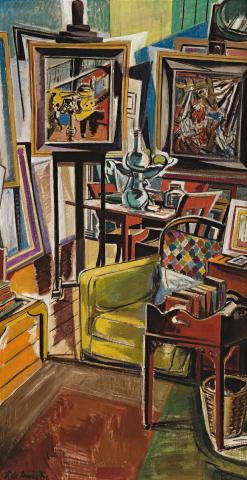STUDIO INTERIOR
ROY DE MAISTRE
oil on canvas
93.0 x 48.0 cm
signed lower left: R DE MAISTRE.
Private collection
Leonard Joel, Melbourne, 6 May 2002, lot 200
Eva Bruer Art Dealer, Sydney (label attached verso)
Private collection, Sydney
Johnson, H., Roy De Maistre, The English Years 1930 – 1968, Craftsman House, Sydney, 1995, pl. 21, p. 50 (illus.)
Roy de Maistre left Australia permanently in March 1930 and eventually based himself in London. For the next few years, he exhibited and worked with members of London's avant-garde, and mentored a young Francis Bacon in the mechanics of painting and the importance of art history. His own living conditions were unsettled but with the support of patroness Sydney Butler, de Maistre was able to move into a three-storey building at 13 Eccleston Street in 1937. He would live here for the remainder of his life. De Maistre used the ground floor as the studio and leased the remaining rooms to a range of associates including the writer Patrick White. His biographer Heather Johnson describes the Eccleston Street studio as 'one of de Maistre's greatest works of art, and the one most appreciated by friends, relatives, and acquaintances.'1 His studio was not simply a work place, but also a domestic and private one. Visitors experienced 'a brilliant orchestration of cluttered objects, chosen for colour, and light, and form, and for their sentimental associations. It seemed that the environment created in this room was a greater work of art than any of his paintings in isolation.'2 De Maistre also kept many paintings from his long career scattered around the studio on walls and easels, or leaning against the wall.
In her seminal publication on the artist, Heather Johnson selected Studio Interior for an extended analysis, noting'easels, canvasses, furniture and objects are compressed physically and as well visually flattened into the almost non-existent space of the paint surface. [The elements] retain a harmony - achieved by the repetition of the vertical lines and rectangular shapes of the frames, easels and furniture legs- and a complete readability. De Maistre has drawn on his knowledge of Cubism to show the relationship between space and form, but has not treated the forms as individual objects, each fractured into its own planes and surfaces. He has instead treated the corner of the studio as a complete object/form in itself 'a doorway in the background is flattened against the table and chairs, in turn joined in a homogenous whole to the easel, the yellow armchair and book-table. The study of penetration of space into this form is as analytical as the analytic cubist works of Picasso and Braque.'3
Paintings by de Maistre of the Eccleston Street interior and its various elements may be found in the collections of the Tate Gallery, London (Interior with Lamp, 1953) and the Arts Council of Britain (The Green Shade, 1949). In 2006, the National Gallery of Australia set the price record for a painting of de Maistre's with their purchase of New Atlantis, c1933 which depicts the equally jumbled studio of his 24 year old protege Francis Bacon.
1. Johnson, H., Roy de Maistre: the English Years 1930 - 1968, Craftsman House, Sydney, 1995, p. 48
2. Thomas, D., 'The Ear of De Maistre', Sunday Telegraph, Sydney, 30 May 1971, p. 60
3. Johnson, H., op. cit., pp. 48, 52
ANDREW GAYNOR
